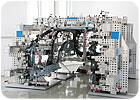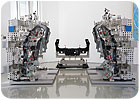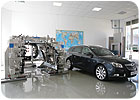
By reducing the number of conventional fixtures, companies will be reducing the amount of scrap at the end of a program. Source: Witte and General Motors Europe
Opinions abound on the environment, so instead of adding to the ongoing global debate, the focus here is on recycling. Recycling is not a new concept; today we recycle paper, glass, plastic and many other materials to reduce waste, but recycling fixtures through retooling might be new.
What does recycling fixtures in manufacturing and quality labs have to do with the environment? Actually, a lot. Scrap within most manufacturers is measured in the amount of waste within the manufacturing area and typically does not include fixturing since it is treated as a program-by-program cost. But scrap also occurs in the fixturing area; every time a program ends or is cancelled, the fixtures are sent to storage, sold off or destroyed. Some go to the scrap yard to be recycled, but there is a cost involved in the process, not to mention the pollutants that are created. Additionally, in most manufacturing companies scrap is a frequent line item that needs to be reduced.
While companies continuously explore internal ways to reduce waste, solutions such as flexible fixturing over conventional fixturing start to make more sense. When a company implements a recycling through retooling program, fixturing for a three- to five-year program will typically recoup costs during the second program, whereas conventional fixtures will continue to generate costs program after program. OEMs can benefit from the multiple reuse strategies throughout their supply base by implementing a flexible fixturing strategy, which would create long-term savings. Even if a supplier is replaced, they can move the flexible fixtures to the new supplier and continue to benefit from their investment.
Suppliers also can save money through multiple retooling applications available to those that embrace this type of fixturing. Retooling programs typically generate instant cost savings to the point where the fixturing would almost pay for itself upon the second application.
So, flexible fixtures provide companies with recycling programs, but not in the typical recycling sense, which is recycling through scrap. This solution-recycling through retooling-focuses on repurposing up to 90% of the original fixture, providing a true recycling program without losing the quality or precision of the fixtures. One major advantage is the ability to carry the cost over multiple programs, providing thousands or even millions of dollars of savings in the process.
Cost savings, as mentioned, is one of the advantages to this type of system. With that said, let’s explore three programs based on flexible conventional fixturing. The following examples are actual numbers from existing vehicle programs. Some manufacturers provided data, but requested that their name and company name not be mentioned.<

Flexible fixtures provide companies with recycling programs, but not in the typical sense of recycling through scrap. Source: Witte and General Motors Europe
Introducing Modular Fixtures
In this example we will look at three vehicle programs A, B and C. There is no overlapping of these particular programs.Starting with the conventional fixture, the initial tooling for program A was $342,000, program B tooling was $362,000 and program C was $355,000, with all three programs totaling more than a million dollars. This results in three different fixtures and once the manufacturer reaches program C, there will be two fixtures that need to be stored, disposed of or recycled.
The flexible fixture initial tooling for program A was $380,000, retooling costs for program B and C were approximately $76,000-a savings of $304,000 per fixture-with an overall for all three programs equaling $532,000-almost half of the conventional fixturing costs.
In this example, 80% of the fixturing was repurposed for programs B and C. The company ends up with no leftover fixtures, limited scrap from program-specific contour blocks and significant savings.

Retooling programs typically generate instant cost savings to the point where the fixturing would almost pay for itself upon the second application. Source: Witte and General Motors Europe
Fixtures on the Floor
The quality team at General Motors Europe (GME) has used modular fixtures for several years, and they have found that launching a new car line, including two to four derivates, is much easier when you have a single fixture with all locators in position and in addition, the locators for all assemblies that are unique to the derivates. A key item for GME is that all locators are changeable and maintain a high level of accuracy in repeating the positions. All part positions are referenced to the grids given by the modular frames and plates, saving time during setup. This has already saved money compared to the fixturing technology that was used in the past.After the start of production, GME reused a high degree of existing modules that were dedicated for launch activities only. They implemented this reuse approach with their global midsize in 2007 to learn more about the benefits of this system.
Today, all modules that have been used for launch activities only have been reused by approximately 70% in total throughout the last two years. Reusing all modules used to launch a former model has saved the company approximately a half-million Euros (or $750,000). To this end, it would be safe to say that they have eliminated unnecessary fixtures with this one flexible system, so in theory they have reduced scrap levels, as it pertains to fixturing.
A match metal fixture also was created for GME. The initial fixture was built for Saab to check a midsize sedan, wagon, coupe and convertible models. They saved money with the fixture for the initial model, since they were able to incorporate four models into the one fixture. After the Saab model was complete, it was repurposed for an Opel model; again GME was able to use this fixture for the current sedan, coupe and wagon with limited retooling. As the current model starts winding down, this fixture is slated to be retooled for a future Opel model, making it the third iteration. The cost savings are significant when compared to the amount of conventional fixtures needed to perform the same tasks.

General Motors Europe was able to get the most out of the flexible match metal fixture system by using it for the sedan, coupe and wagon with limited retooling. Source: Witte and General Motors Europe
New systems provide some of the answers to a lot of challenging questions. How can a manufacturer reduce costs? Think long-term over short-term by implementing a flexible fixturing strategy.
How can a manufacturer reduce scrap? Implement a recycling through retooling strategy.
By reducing the number of conventional fixtures, companies will be reducing the amount of scrap at the end of a program. Through the conversations with the financial end of the business, it appears the few administrative changes that they had to implement to be able to move budget or savings across programs were well worth it and they only had to be done once. But the costs savings are something that they will keep getting throughout the programs.
As stated at the beginning, how we approach the environment has a lot to do with one’s own opinion, but in this case anytime someone can reduce cost and waste, and truly recycle without giving up high standards of quality, that opinion starts to become a fact.Q
Tech tips
- To reduce costs, think long-term over short-term by implementing a flexible fixturing strategy.
- By reducing the number of conventional fixtures, companies will be reducing the amount of scrap at the end of a program.
- The cost savings are significant when comparing one flexible fixture to the conventional fixtures needed to perform the same tasks.